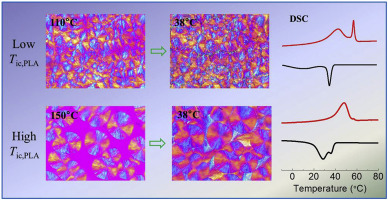Polymer ( IF 4.1 ) Pub Date : 2020-01-14 , DOI: 10.1016/j.polymer.2020.122189 Jianna Bao , Xiaolei Dong , Shichang Chen , Wangyang Lu , Xianming Zhang , Wenxing Chen

|
Stereocomplexation has been an effective way to improve the physical properties of block copolymers or blends. However, the effect of stereocomplexation on the confined and fractionated crystallization of other crystallizable block has not been comprehensively investigated so far. In this work, we used poly(l-lactide) (PLLA) and poly(d-lactide) (PDLA) as stereocomplexable higher melting component and studied the confined crystallization and melting behavior of poly(ethylene glycol) (PEG) in their block copolymers and blends. Unexpectedly, marked fractionated crystallization and fractionated melting behaviors of PEG component occurred during the two-step crystallization process, because of the constrained effect of the early formed stereocomplex (SC) crystals. The fractionated crystallization and melting behaviors were further facilitated with decreasing the isothermal crystallization temperatures of PLLA and PDLA (Tic,PLA). As revealed by polarized optical microscopy (POM), the increase of Tic,PLA favors the transformation of PEG component from the interlamellar to interspherulitic regions due to the reduced nucleation density of PLA. We proposed that fractionated crystallization and fractionated melting behaviors of PEG impacted by SC crystals were attributed to PEG component dispersed in and out interlamellar regions of PLA matrix. Moreover, small-angle X-ray scattering (SAXS) results indicated that two scattering peaks were identified for copolymers after two-step crystallization process, one consisted of mixed PEG and PLA lamellae and the other contained almost pure PEG lamellae originated from the crystallization of PEG dispersed in interfibriller/interspherulitic regions. This study has shed light on the unique fractionated crystallization and fractionated melting behaviors of the lower melting component in miscible polymers systems with the higher melting component preferentially co-crystallized into SC crystals.
中文翻译:

聚丙交酯立体配合物在其嵌段共聚物和共混物中诱导的聚乙二醇的分步结晶和分馏熔融行为
立体络合一直是改善嵌段共聚物或共混物物理性能的有效方法。然而,到目前为止,立体络合对其他可结晶嵌段的受限和分级结晶的影响尚未得到全面研究。在这项工作中,我们使用了聚(l-丙交酯)(PLLA)和聚(d-丙交酯(PDLA)作为可立体络合的较高熔点组分,并研究了聚(乙二醇)(PEG)在其嵌段共聚物和共混物中的受限结晶和熔融行为。出乎意料的是,由于早期形成的立体配合物(SC)晶体的约束作用,在两步结晶过程中发生了明显的PEG组分分级结晶和分级熔融行为。降低PLLA和PDLA的等温结晶温度(T ic,PLA)进一步促进了分馏结晶和熔融行为。偏光光学显微镜(POM)显示,T ic,PLA升高由于降低了PLA的成核密度,利于PEG成分从层间到球间区域的转化。我们提出,SC晶体对PEG的分级结晶和分级熔融行为均归因于PEG成分分散在PLA基质层间区域内外。此外,小角X射线散射(SAXS)结果表明,在两步结晶过程后,共聚物共发现了两个散射峰,一个由混合PEG和PLA薄片组成,另一个包含了几乎纯的PEG薄片,这些峰来自于结晶。 PEG分散在纤维间/细胞间区域。











































 京公网安备 11010802027423号
京公网安备 11010802027423号